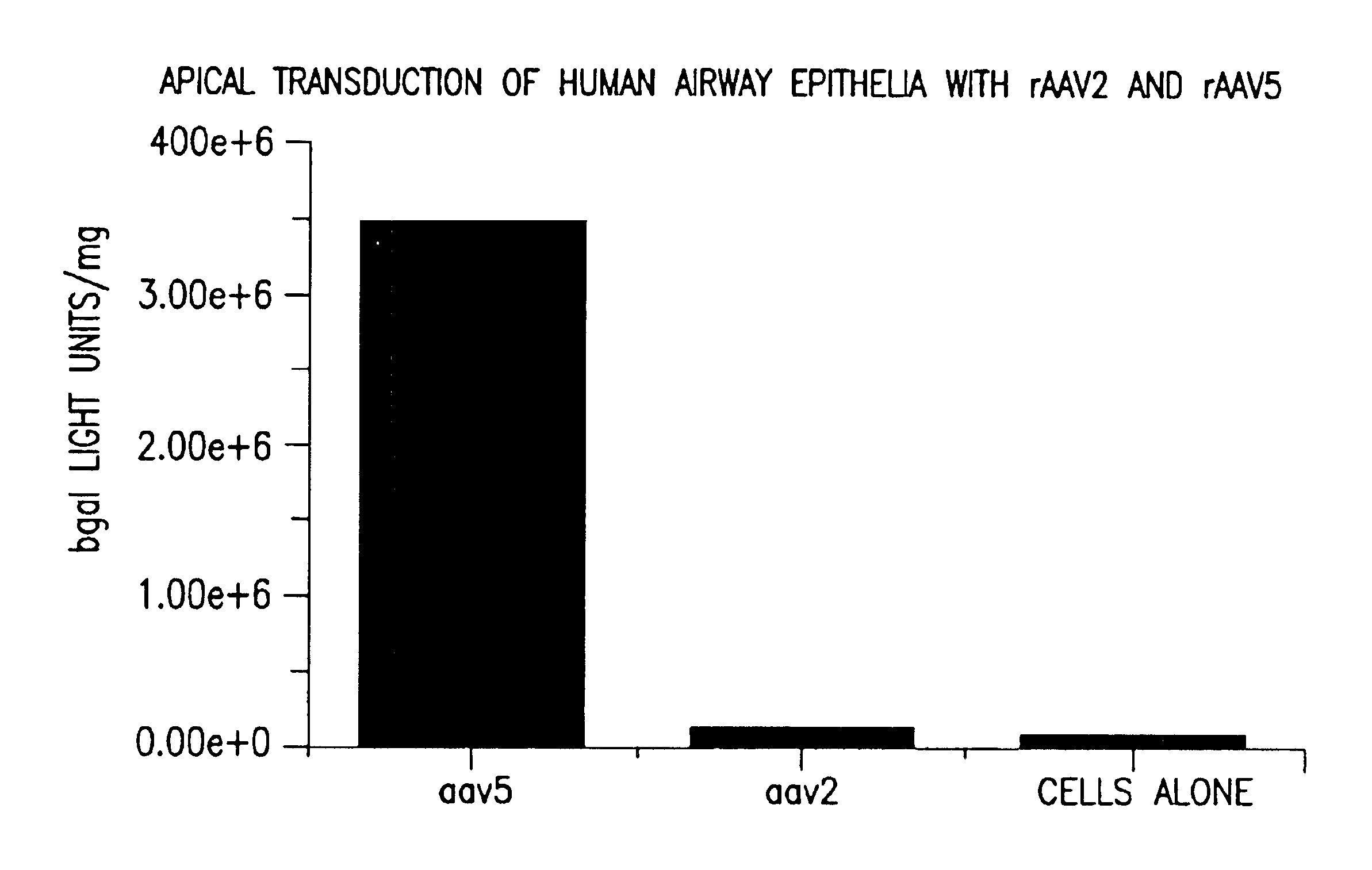AAV5 vector for transducing brain cells and lung cells
- Summary
- Abstract
- Description
- Claims
- Application Information
AI Technical Summary
Benefits of technology
Problems solved by technology
Method used
Image
Examples
example i
[0156]To understand the nature of AAV5 virus and to determine its usefulness as a vector for gene transfer, it was cloned and sequenced.
[0157]Cell Culture and Virus Propagation
[0158]Cos and HeLa cells were maintained as monolayer cultures in D10 medium (Dulbecco's modified Eagle's medium containing 10% fetal calf serum, 100 μg / ml penicillin, 100 units / ml streptomycin and IX Fungizone as recommended by the manufacturer, (GIBCO, Gaithersburg, Md., USA). All other cell types were grown under standard conditions which have been previously reported.
[0159]Virus was produced as previously described for AAV2 using the Beta galactosidase vector plasmid and a helper plasmid containing the AAV5 Rep and Cap genes (9). The helper plasmid was constructed in such a way to minimize any homologous sequence between the helper and vector plasmids. This step was taken to minimize the potential for wild-type (wt) particle formation by homologous recombination.
example ii
[0173]Transduction of Airway Epithelial Cells
[0174]Primary airway epithilial cells were cultured and plated as previously described (Fasbender et al. J. Clin Invest. 1998 Jul. 1; 102 (1): 184-93). Cells were transducted with an equivalent number of rAAV2 or rAAV5 particles containing a nuclear localized β-gal transgene with 50 particles of virus / cell (MOI 50) and continued in culture for 10 days. β-gal activity was determined following the procedure of (Chiorini et al. 1995 HGT Vol: 6 1531-1541) and the relative transduction efficiency compared. As shown In FIG. 7, AAV5 transduced these cells 50- fold more efficiently than AAV2. This is the first time apical cells or cells exposed to the air have been shown to be infected by a gene therapy agent.
[0175]Transduction of Striated Muscle
[0176]Chicken myoblasts were cultured and plated as previously described (Rhodes & Yamada 1995 NAR Vol 23 (12) 2305-13). Cells were allowed to fuse and then transduced with a similar number of particles o...
example iii
[0183]Vector Production
[0184]Recombinant adeno-associated viral vectors based on AAV2, AAV4, or AAV5 were prepared using high efficiency electroporation and adenovirus infection as described previously (9). All three vectors contained a nucleus-targeted E. coli β-galactosidase gene with expression driven off the Rous sarcoma virus LTR promoter (RSV). The expression cassette was flanked by AAV2 ITR sequences for rAAV2βgal particles and rAAV4βgal particles. The expression cassette was flanked by AAV5 ITR's for rAAV5βgal particles. The number of recombinant particles were quantified by Southern dot blot, and the biological activity was tested by X-Gal histochemical staining in a serial dilution on Cos cells. The viral titers ranged between 2×1011 to 3×1012 particles / ml and the ratio of transducing to total particles was similar to that described previously for each of the types (9,10,45). The recombinant viruses used were screened for wild-type AAV contamination by PCR, and for wild-ty...
PUM
 Login to View More
Login to View More Abstract
Description
Claims
Application Information
 Login to View More
Login to View More - R&D
- Intellectual Property
- Life Sciences
- Materials
- Tech Scout
- Unparalleled Data Quality
- Higher Quality Content
- 60% Fewer Hallucinations
Browse by: Latest US Patents, China's latest patents, Technical Efficacy Thesaurus, Application Domain, Technology Topic, Popular Technical Reports.
© 2025 PatSnap. All rights reserved.Legal|Privacy policy|Modern Slavery Act Transparency Statement|Sitemap|About US| Contact US: help@patsnap.com



